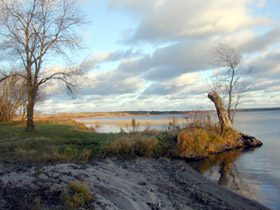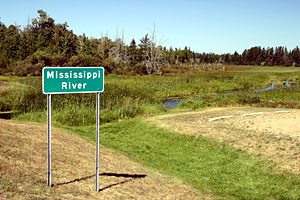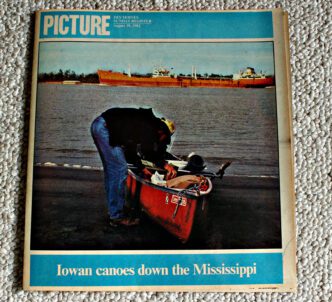“It was here that we saw the Indians, even at this early period of the year, gathering their wild rice harvest. Several canoes were at work (men and women) in a flooded marsh. The men cut off the green heads of the river plant and let them fall into the canoe, while women stowed them away. Great was the merriment.” (- John J. Bigsby, early 1800s, near the Canadian border with the boundary commission.)
Mike and I considered the wild rice beds along the shore of Cass Lake to be a nuisance. Some were several acres in size, forcing us to stay in the middle of the lake to make any progress.
It was eight miles across the lake and we paddled and paddled and it seemed the opposite shore never did get much closer. Rain threatened, so we stayed near land when possible and kept digging in. Finally, after several hours, we got to the dam.
Cass Lake is fed from the west and drained to the east by the Mississippi. In 1820, an expedition led by General Lewis Cass, after whom Cass Lake is named, erroneously identified the lake as the source of the Mississippi. In 1832, Henry Schoolcraft, who had been on that 1820 expedition, identified the actual source of the river as being Lake Itasca.
In the middle of Cass Lake is Star Island. It is noted in “Ripley’s Believe It or Not” for having its own lake, Lake Windigo, which makes it a lake within an island within a lake.
On shore, near the landing, a young man was watching for canoes in his binoculars. He was a member of the Kuintyle family, from a place I didn’t catch, and the family was attempting to break the Guinness World Record from Lake Itasca to New Orleans.
“The group that currently holds the record is British,” the young man explained. “We thought we should bring that record back over here.”
The paddlers -Robert Kuintyle Sr. and Robert Jr. – had to paddle 60 miles that day. They’d covered the distance from Lake Itasca to Cass Lake in two days. And they’d have to keep up that pace for almost two months.
My blood ran cold and the sweat popped out on my forehead at the thought of the effort needed to break that record. I’m as patriotic as the next guy, but that’s one record the Brits can keep.
Mike and I set up camp, then hung around the landing to watch the paddlers come in. The Kuintyles came gliding in an hour or so after dark. They wasted no time getting out of the 17-foot aluminum canoe so they could stretch.
Their itinerary re-enforced my desire to have nothing to do with endurance records. They planned on averaging a minimum of 60 miles per day, and once they got to St. Paul, they thought they could go faster.
By comparison, the Pantenburg voyage was lethargic, disorganized and lacked drive and purpose. We did well to cover 20 miles in a day, since we seldom passed up an inviting fishing or swimming hole. I never missed an interesting person if I could help it, and Mike was used to going along on interviews.
We wished the Kuintyles well in their record attempt, then went back to our camp. While Mike sat by the fire, I pulled out a book I’d picked up in Bemidji and read about the wild rice.
To the Indians, the rice beds were a source of wealth. The Chippewa Indians living on the Leech Lake Indian Reservation think the beds are a gift from God. Wars have been fought and treaties signed to guarantee the right to harvest the wild rice. Today, wild rice is still important to the Indian people.
Curious about the whole cultural and economic interaction, I looked up Joe Shepherd, hydrologist with the Leech Lake Reservation Department of Natural Resources. According to Shepherd, 90 percent of the world’s wild rice supply comes from Minnesota, and most of that comes from Cass Lake.
“We’re the wild rice capital of the world,” he claimed. “The reservation has about 15,000 acres of beds, and every year, about 2,000 boats are involved in the harvest.”
By law, all rice is gathered in the traditional Indian way, using teams of two people in one canoe. One person stands in the back with a long pole and pushes the boat through the rice beds, while the other sits in the bottom and knocks the ripe grain into the bottom.
There may be more efficient ways of harvesting, but the residents will have none of that.
“The rice belongs to everybody,” Shepherd said. “If the harvest method was improved, there is a chance that somebody might not get any.”
The rice harvest could be compared to some Christian holidays. For the Indians, the harvest is a time to gather rice, visit friends and family, and socialize.
Beside tradition, ricing also supplies a major source of income on a reservation where unemployment is about 35 percent. The finished rice sells for about three to five dollars a pound on the reservation and some ricers will make several thousand dollars during the season.
“The prices for rice get higher the further away from Minnesota you get,” Shepherd said. “In Midwest grocery stores, the rice may cost six dollars for a six-ounce pack. I’ve heard of wild rice bringing $24 for six ounces in Los Angeles.”
With so much at stake, a good ricer gatherer – a “knocker” in reservation vernacular – is a respected person in the community.
One of the best rice gatherers is Scott Headbird, a 58-year-old Chippewa who lives on the north shore of Cass Lake. As the seasons call for it, he is a carpenter, fisherman and sometimes trapper. During October he is a knocker.
Shepherd gave me a ride. When we drove up to Headbird house, Scott was sitting on his picnic table, carving rice-knocking sticks. Tribal law requires knocking sticks to be under 36 inches long and weigh less than a pound. Headbird does a brisk business selling knocking sticks each year.
“My father and grandfather and everybody back as far as anyone can remember gathered the rice,” he said. “I still parch and clean the rice the same way my ancestors did.”
Most ricers sell their rice just as it comes out of the canoe. Considered “green,” it doesn’t bring the highest prices and it must be dried and cleaned before it is sold. When the Headbirds bring in a load, it is prepared in the traditional way. A black iron kettle has a fire built under it and the rice is toasted.
After it is cooked sufficiently, Headbird puts on clean buckskin moccasins and “dances” on the rice to remove the husks. Then, the rice is put in a birchbark basket, and “jigged” in the air and the wind removes the chaff. The finished product is worth the extra effort, or at least, it used to be.
“I started ricing when I was seven years old, and for years it was my main source of income,” Headbird said. “Nowadays, the competition is just too stiff. “
Commercial growers have discovered wild rice, and each year, they produce more of the crop. Carefully fertilized and supervised rice beds, plus mechanical methods of harvesting allow these modern wild rice growers to sell at a lower cost.
Headbird looks at this progress with a sinking feeling. If the profit goes out of the rice, then another traditional way of making a living will be gone.
“There is no work on the reservation, and every year there are more ricers,” he said. “Now the season only lasts about two weeks before all the rice is gone.”
Mechanization would mean the end of Headbird’s lifestyle, but he intends to continue with the traditional harvest methods as long as he can.
“It is a way of life that has been handed down to me from my ancestors as far back as I can remember,” he explained. “I hope I will be able to hand it along, too.”







Leave a Reply